By Tyler Rossi for CoinWeek …..
History is a continuum and time moves linearly. Generally, as time progresses, artistic and cultural trends evolve and build upon each other. One perfect example is the Hellenistic influence seen in Buddhist artwork from the Gandharan province in the first century BCE. The Bactrian and other Greek kings who ruled segments of Alexander the Great’s empire after his death brought significant Western artistic conventions along with their armies. These pieces of “Greco-Buddhist” art are proof of an East-West exchange of ideas that has existed for almost all of recorded history.
An example of the Gandhara Greco-Buddhist style, the statue of Gautama Buddha seen below, is emblematic of the cultural melding. The robes worn by this buddha are “extremely fine” and are treated in the “realistic” Greek style. Additionally, the statue’s hands and feet are carved in a very western fashion. This cultural syncretism arose because of continuous historic contact via the overland trade routes from China in the east to the western Greco-Roman world.
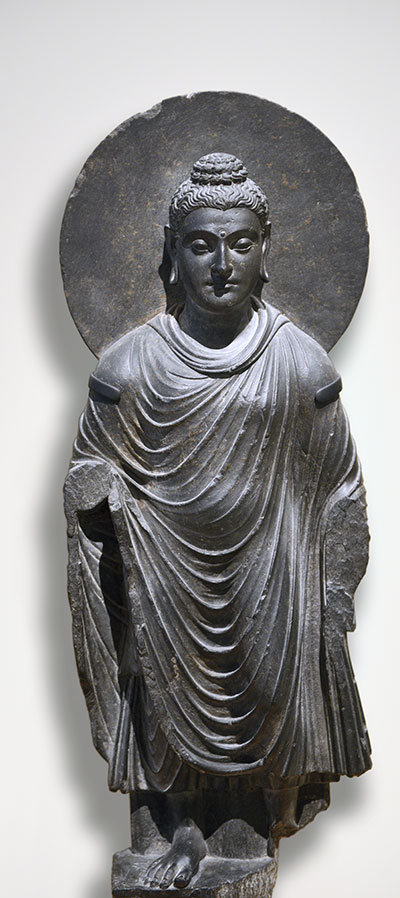
Coins are no different.
As discussed in previous articles, coins have always been vehicles of cultural and political messaging for the minting authority. Consequently, coins are as much a barometer for cultural merging and influences as any other type of artwork.
Egyptian and Greek Influences on Roman Coins
As reported by the ancient (but not coeval) historians Livy and Dio Cassius, Ptolemy II Philadelphus initiated official contact between Rome and Egypt when he sent an embassy in 273 BCE to Rome in response to their earlier defeat of Pyrrhus of Epirus. This alliance between Republican Rome and the “aggressive Hellenistic ruler” of Egypt marked the start of centuries of cultural exchange and dominance. More immediate, however, was the “monetary convention” agreed between the newly minted allies. Of interest was how the agreement stated that the two powers would “issue parallel coins for fifty years”.
Harold Mattingly, a noted numismatist at the British Museum, discusses the significant design similarities between early Roman Republican silver and contemporary Egyptian coinage. One of the main common artistic design traits of Ptolemaic coins is the “deep shadowing of the eyes.” The obverse design of a youthful Hercules on this early Roman didrachm minted between 270-265 BCE, shortly after the Roman-Egyptian diplomatic agreement, is very similar to a tetradrachm struck by Ptolemy II Philadelphus only a few years earlier circa 285-270. Not only are the deep-set eyes and facial shadowing similar, but the busts of young Hercules and Ptolemy I have very similar prominent chins and noses, and their hairstyles are remarkably similar.
The early Roman and Ptolemaic silver coinages were so similar that Eleanor Huzar even suggested that Rome may have contracted an “Alexandrian moneyer” to carve their initial dies.
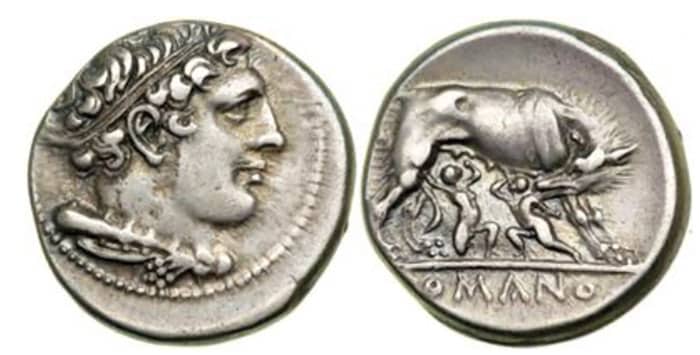
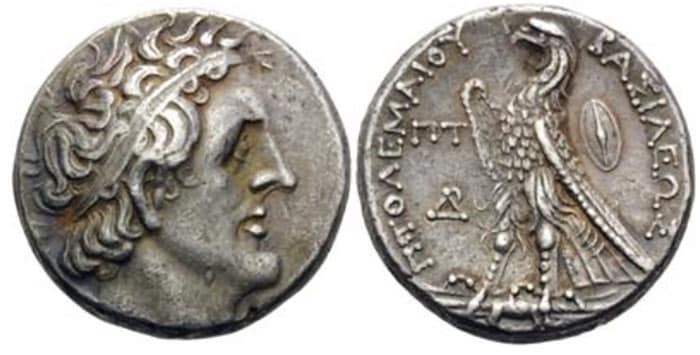
Another similarity that persisted for almost one hundred years between the two currencies was the use and specific depiction of the eagle. While the actual use of an eagle as numismatic imagery is nothing special, many cultures have included images of eagles on their coins throughout history, the specific way the bird is standing and holding its head is practically identical between the Roman and Egyptian coins of the second through first centuries BCE.

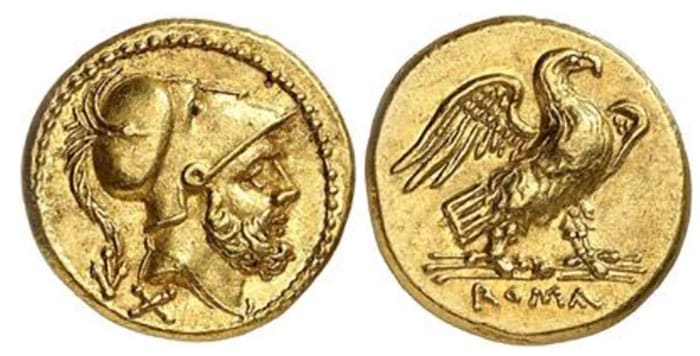
Also, by looking at later Roman coins, numismatists can see that the birds on these early coins are standing in an “un-Roman” stance. Besides the fact that these two birds are facing the opposite direction, their outspread wings are almost identical.
Roman Influences on Medieval and Modern Coinage
As time passed and power waned, Roman coinage evolved and spread to cover the entirety of the known world under direct Roman control and their extended suzerainty. Thus, their coins became a powerful force in Europe, extending down through history to influence medieval and early pre-modern coinage – the most pervasive impact being the use of Latin legends as “verbal statements of position” in announcing the Monarch’s official titles.
One famous instance of such adoption of imagery is the Augustale of King Frederick II of Hohenstaufen. This coin depicts Frederick in an idealized portrait as a Roman emperor. It is thought that the portrait is based on a cameo of Tiberius that was held at Aix-la-Chapelle, yet the legends and reverse are comparable to an early imperial Roman denarius or tetradrachm.

A few centuries later, on orders from Charles II, the British Royal Mint borrowed heavily from Hadrian’s coinage when they designed the seated Britannia reverse of their coinage. Rediscovered in the 17th century, the Britannia design had not been seen since on British coins since Rome abandoned the island in 410 CE. By 1636, in a statement meant to legitimize growing British maritime power, the legal scholar John Selden “argued that Britannia proved Britain’s claim to the seas around her. He said that Britannia had been shown on Roman coins seated amidst the waves, portraying our naval strength”. Thirty-six years later in 1672, Britannia was pictured once again on British coins.
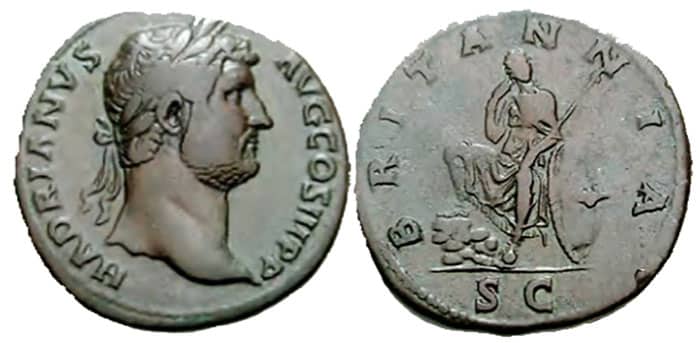
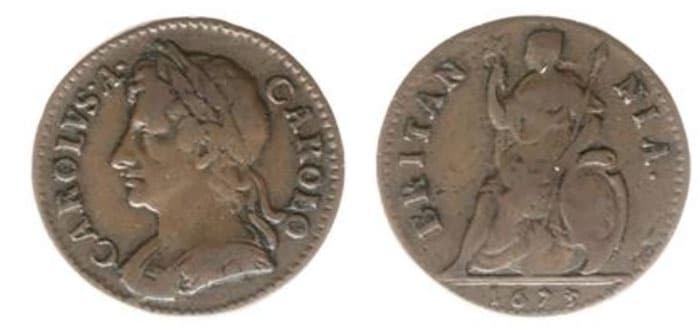
Over the centuries, as the seated figure of Britannia became synonymous with Great Britain, the United States looked to it for inspiration. Christian Gobrecht’s design is “unmistakable” as an adaptation of England’s Britannia, the main difference being that, instead of an allegory for an entire nation, Gobrecht’s lady is the personification of Liberty. Her shield is a different shape, and the design includes a pileus cap hanging off a staff. Starting in 1836 this figure, known colloquially as Seated Liberty, was employed on the half dime, dime, quarter, half dollar, and silver dollar. The Gobrecht “Seated Liberty” design was used until 1891.
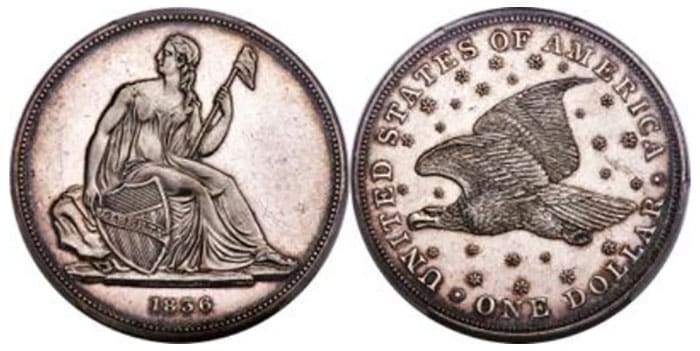
Following down the timeline, American coins have served as patterns and inspirations for currencies around the world.
In the early 20th century, during America’s imperialistic push into the Pacific, the United States Mint struck a series of coins for the Philippines from 1903-1945. The larger denomination coins featured a female figure of Liberty holding a hammer over an anvil in front of an erupting volcano. While technically this was the US striking coins for the Philippines, and not the Philippine government designing their own coinage, it is still an interesting expansion of US designs.
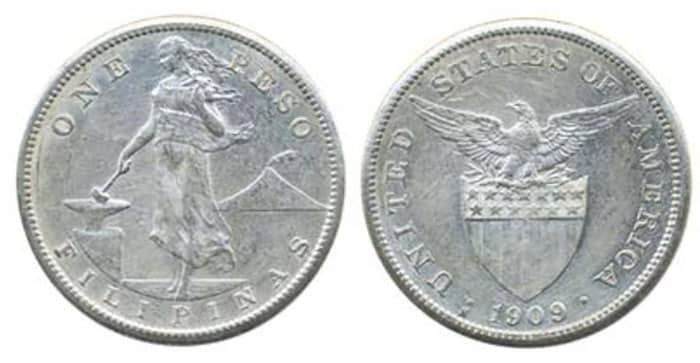
As Henrietta Fore, the 37th director of the US Mint, said while addressing a directors’ forum, “Coins are, in a very real sense, history in your pocket”. I would go even further and say that the designs are living things, ever evolving and changing. Different governments employ existing imagery as their own in an attempt to claim past glories. One can easily connect designs on modern coins to ancient coins struck over two thousand years prior.
This connecting past and present would be an interesting theme for a collector!
* * *
Sources
https://www.jstor.org/stable/pdf/500230.pdf?refreqid=excelsior%3A9b4174f465479f16a56c4223c8cd3527
https://www.metmuseum.org/toah/hd/gand/hd_gand.htm
http://www.hellenicaworld.com/Greece/Art/Ancient/en/GrecoBuddhistArt.html
https://www.jstor.org/stable/pdf/3294746.pdf?refreqid=excelsior%3Ab24fed9365f9871edc4c3dd4cfda4d58
https://brill.com/view/book/edcoll/9789004383098/BP000001.xml
https://www.royalmint.com/discover/britannia/britannia-on-british-coins/
https://www.wilsoncenter.org/article/the-international-business-the-us-mint
* * *
About the Author
Tyler Rossi is currently a graduate student at Brandeis University’s Heller School of Social Policy and Management and studies Sustainable International Development and Conflict Resolution. Before graduating from American University in Washington D.C., he worked for Save the Children creating and running international development projects. Recently, Tyler returned to the US from living abroad in the Republic of North Macedonia, where he served as a Peace Corps volunteer for three years. Tyler is an avid numismatist and for over a decade has cultivated a deep interest in pre-modern and ancient coinage from around the world. He is a member of the American Numismatic Association (ANA).




